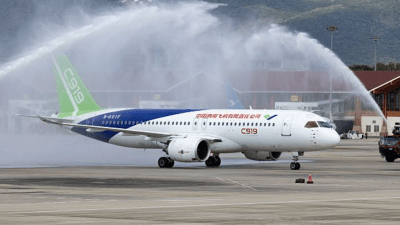
In a recent flight test ahead of its commercial operation scheduled in late February, China’s self-developed C919 narrow-body passenger jet ran into a problem.
Chinese media reported that a C919 jet of China Eastern Airlines took off at the Shanghai Hongqiao International Airport at 9:45am on February 1 and landed at the Beijing Capital International Airport at around noon. As one of its engines during landing failed to open the thrust reverser, which is designed to slow down the plane, the planned journey on to Hefei was canceled and the plane returned to Shanghai.
Air engineering experts said that although a failure in thrust reversal is not a big problem, China Eastern probably will have to push back the plane’s commercial launch. They said an initial investigation found that the failure was caused by some problems in foreign-origin parts.
Those parts are produced by CFM International, a 50-50 joint venture between American GE Aviation and French Safran Aircraft Engines.
Commercial Aircraft Corp of China (Comac), founded in 2008 and headquartered in Shanghai, said last August that its C919 airliner had completed all test flights.
The company said it had submitted the C919 test results to the Civil Aviation Administration of China (CAAC), the country’s aviation regulator, and would wait for official certification to fly. It was expected that the C919’s official launch would take place in 2023 or 2024.
Chinese media said the C919 ultimately aims to compete with France’s Airbus A320 and America’s Boeing 737.
The foreign joint venture parts-maker CFM also contributed the high-bypass turbofan engine known as the leading edge aviation propulsion (LEAP) to the C919.
The problem was rumored earlier this week when some netizens said the C919 had failed a flight test on February 1. Chinese media then disclosed more details about the incident.
China Eastern Airlines and Comac so far have not made any official announcement about the incident.
A Shenzhen-based columnist said the thrust reversal problem would be dangerous only if both engines failed to reverse the thrust during the landing. In such a case, it would be safe to land only on a longer runway leaving room to decelerate.
He said China Eastern Airlines originally planned to start the C919’s commercial operation in late February, or within the coming two months. He said the launch would probably have to be postponed.
A Hunan-based writer said a failure in thrust reversal would not affect the normal flying of the C919 but it was likely that this incident had affected its plan to complete its first 100-hour flying test.
He said the C919 chose to return to Shanghai instead of heading to Hefei as the latter’s airport might not have a long enough runway for it to slow down.
On December 9 last year, China Eastern Airlines received the first C919 jet from Comac. On December 26, the airliner, with a flight number MU919, took off in Shanghai, starting to fly for its first 100 hours. Passing this test is essential for China Eastern Airlines to get a certificate for the plane’s commercial operation.
Chinanews.com reported that a C919 plane flew from Shanghai to Sanya in southern China’s Hainan province and then went to Harbin in Heilongjiang in the country’s far north on Wednesday.
It said it was the first time for the plane to appear in Sanya and Harbin so the two places welcomed it with grand ceremonies.
Experts pointed to negotiations gone awry when they noted that China could have relied on Russian jet technology in a program called CR929 if both sides had managed to agree on a profit-sharing model.
One writer said Comac and Russia’s United Aircraft Corporation (UAC) had decided to jointly develop a wide-body twin jet airliner called CR929 in the past few years but the project could not go on as the Russian side refused to share its technology. He said UAC wanted to have a share in China’s domestic airliner markets.
According to previous reports, Comac and UAC signed a memorandum of understanding for the CR929 program in 2016. It was supposed that UAC would get the international markets while Comac would have the Chinese markets. But Russian Vice-Premier Yuri Borisov said last July Russia’s involvement in the CR929 was decreasing.
A Chinese columnist said that, over the long run, China should continue to develop its jet engine, namely CJ-1000A, and reduce using foreign parts, especially those from the United States. He said the CJ-1000A could be used to substitute for CFM’s LEAP in the future as they are very similar.
Read: China’s C919 poised to challenge Boeing, Airbus
Follow Jeff Pao on Twitter at @jeffpao3

